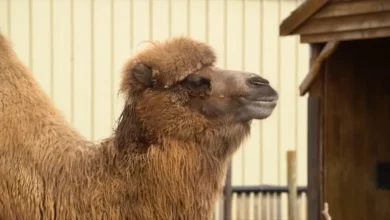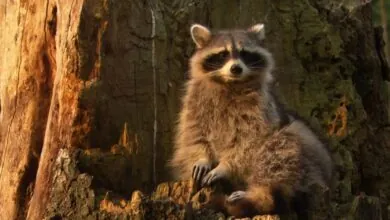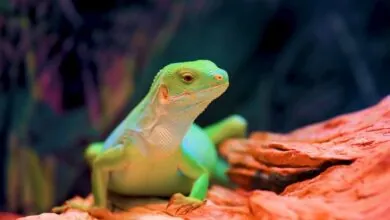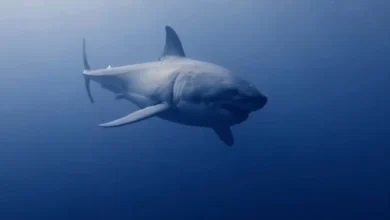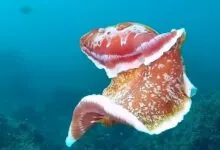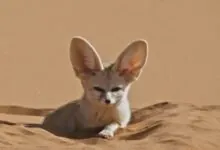Maine Coon Size Matters: How Big Do These Gentle Giants Get?
The Maine coon – a captivating domestic cat breed – is renowned for its striking size and gentle temperament. These creatures are oftentimes referred to as “gentle giants.” In this piece of construct we’re going to dig deep into all aspects of these giants, unpacking its history, playful personality and, of course, Maine coon size. We will explore the scientific factors contributing to their impressive stature, offering a comprehensive insight of these majestic creatures.
| Kingdom | Phylum | Class | Order | Genus | Family | Scientific Name |
| Animalia | Chordata | Mammalia | Carnivora | Felis | Felidae | Felis catus |
Maine Coon Size
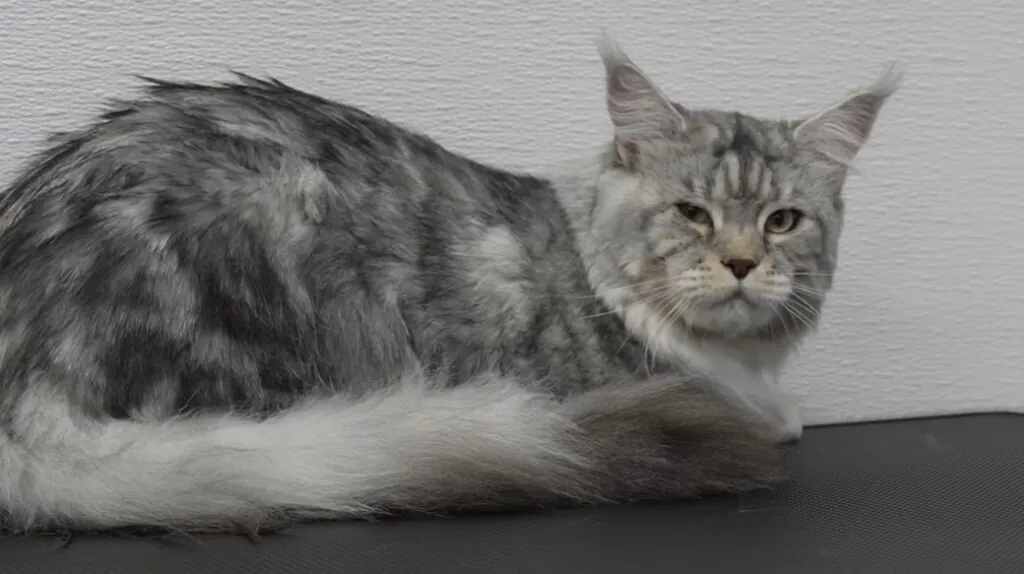
The Maine coon, recognized for its appearance and gentle personality, is the largest domestic cat breed. Understanding their size is essential for responsible Maine coon adoption to make informed decisions about different aspects.
Living Space
These cats need ample room to move around comfortably. Ideally, the Maine coon living space should include vertical space for climbing and perching, like cat trees or shelves and horizontal space for running, jumping and playing.
Nutrition
The Maine coon size entails a specific diet to ensure proper growth and prevent obesity. Let’s spotlight the Maine coon dietary considerations:
Make sure the Maine coon’s diet includes essential vitamins and minerals like taurine (important for heart health), calcium (for bone development) and glucosamine (supports joint health).
Concerning the Maine coon feeding schedule, due to their larger size, they’re prone to overeating. Employ portion control and consider feeding them smaller, more frequent meals throughout the day (2 to 3 meals) instead of one large one.
Maine Coon Size and Weight
Males
Females
Comparison with Other Large Cat Breeds
Siberian: These cats have similar size to Maine coons, slightly stockier build and shorter legs.
Ragdoll: They’ve similar weight range to female Maine coons, slightly smaller overall with a more docile and laid-back personality.
Norwegian Forest Cat: These cats come in similar size and weight range to Maine coons, known for their thick, water-resistant double coat.
Factors Influencing Maine Coon Size
Genetics
Breed lineage and pedigree influence size to a certain extent. Reputable breeders strive to maintain breed standards while preferring the health and well-being of their cats.
Nutrition and Diet
A balanced, high-quality diet promotes healthy growth and prevents obesity. You’re to avoid overfeeding and consult your veterinarian if you’ve any concern about your Maine coon’s weight or growth rate.
Environmental Factors
Ample space for movement and exercise are pivotal for proper development. Offer your Maine coon cat with opportunities to climb, jump and explore their environment to encourage healthy muscle development and prevent boredom.
Scientific Name
The Maine coon share the scientific name Felis catus. This generic name fundamentally unpacks a fascinating story about feline evolution and classification.
The first part of the name – Felis – refers to the broader genus within the animal kingdom that encompasses various types of cats, including domestic cats, wildcats like the African wildcat and jungle cat and even smaller wildcats like the black-footed cat.
The second part – catus – manifests the specific species within the Felis genus. In this case, “catus” identifies the domestic cat itself, enveloping all recognized breeds like the majestic Maine coon, the elephant Persian and the vocal Siamese, albeit their distinct appearances and temperaments.
Origin and Evolution
Evolutionary History
The spot-on origin of the Maine coon remains shrouded in some mystery, with multiple theories proposed. Nonetheless, genetic studies suggest they possibly descended from European short-haired cats brought to North America by early settlers – potentially from Scandinavia or England.
In terms of the Maine coon evolution, they’re thought to be developed through natural selection in the harsh climate of Maine. This environment favored traits, like thick, long fur, large size, water-resistant coat.
Genetic Composition and Diversity
Maine coon share the same Felis catus species designation as all domestic cats. Nevertheless, they sport specific genetic variation that contribute to their unique traits, including mutations in genes associated with fur length, density and ear tufts and variations in size=determining genes compared to other domestic cat breeds.
Environmental Adaptations
These gentle giants are adapted to thrive in the cold, harsh winters and rocky coastline of Maine. Their thick fur, large size and potentially water-resistant fur are believed to be adaptations that help them survive and hunt effectively, withstand cold temperatures and navigate snow and rocky terrain with ease.
Geographic Range
Contemporarily, the Maine coon is chiefly found in North America, specifically in the United States and Canada. They’re popular in their native state of Maine but are also widely owned across North America and other parts of the world. Historical evidence proposes their presence in Maine as early as the 18th century.
Geography
| Continents | North America (specifically, United States) |
| Countries | Primarily United States, but found in other countries due to human introduction |
| Bio-geographical Realms | Nearctic |
| Climate Zones | Can adapt to various climates but generally prefer temperate zones |
5 Maine Coon Facts
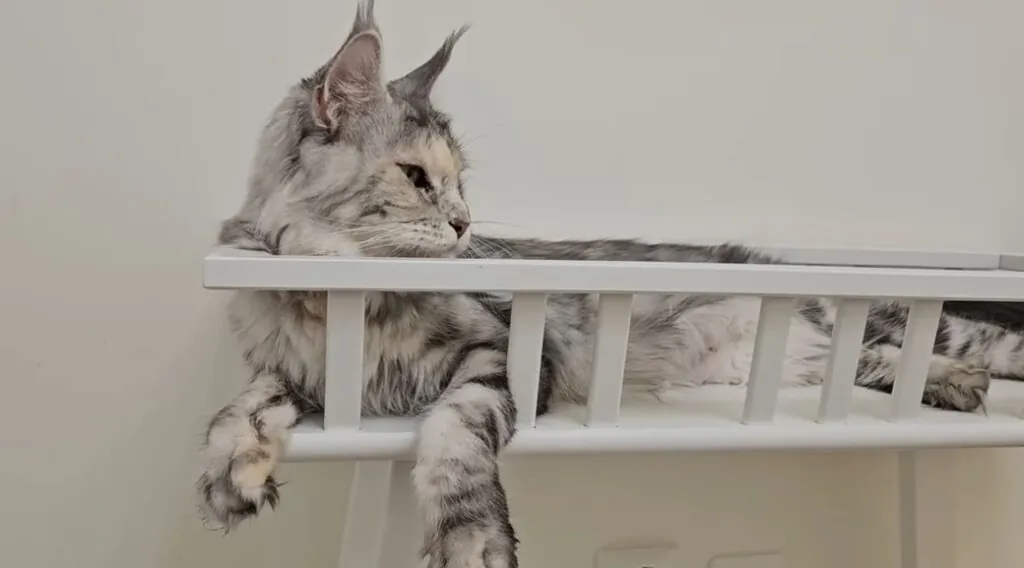
Appearance
Above and beyond the enchanting the Maine coon size, the secrets of their overall appearance beckon further exploration.
Physical Characteristics
Sexual Dimorphism
Male Maine coons are typically larger and more muscular than females. They may have more prominent cheekbones and a more pronounced ruff of fur around the neck as well.
Types of Maine Coon Cats
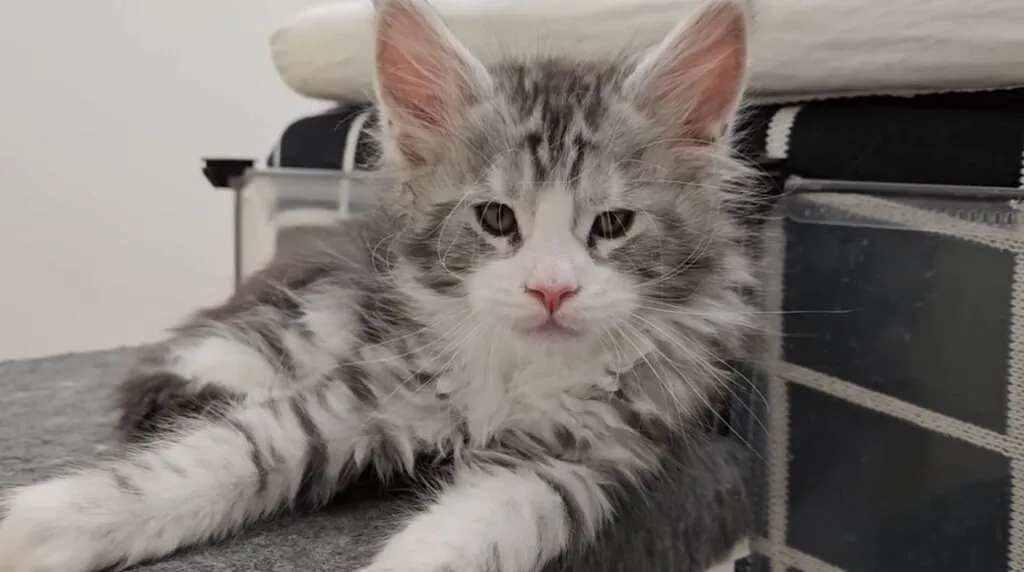
There’re two ways to categorize Maine coon cats: by coat color and by coat pattern. Let’s unfold them.
By Coat Color
Solid: This type of cats comes in a plethora of colors, including white, black, red, cream and blue. Solid white Maine coons are quite rare, making up only about 1.5% of the breed.
Bi-color: Bi-color Maine coons sport two distinct colors, with white always being one of the colors. The most typical bi-color combinations are white and black, white and red and white and cream.
Particolor: Particolor Maine coons have more than two colors in their coat, with white always one of the colors. The most common particolors are calico (white, black and orange) and tortie (white, red and black).
Tabby: Tabby Maine coons have a striped or patterned coat. The most common tabby patterns are classic, macherel and spotted.
Shaded and Smoke: Shaded and smoke Maine coons have a lighter coat color with darker tipping on the fur. Shaded cats have tipping on their legs, tail and head, while smoke cats have tipping all over their body.
By Coat Pattern
Solid: As mentioned above, solid Maine Coons have a coat of one uniform color.
Classic Tabby: Classic tabby cats have a marbled pattern with swirls and bull’s-eyes on their sides.
Mackerel Tabby: Mackerel tabby cats have vertical stripes down their sides and body.
Spotted Tabby: Spotted tabby cats have spots on their sides and body, often with mackerel tabby stripes on their legs and tail.
Bi-color: Bi-color cats have two distinct colors, with white always being one of the colors.
Calico: Calico cats are tricolored, with white, black, and orange patches.
Tortoiseshell: Tortoiseshell cats are also tricolored, but with red and black patches instead of orange.
Van: Van cats have white markings on their face, chest, and legs, with any other color on the rest of their body.
Harlequin: Harlequin cats are bi-colored, with large patches of color on one side of their body and white on the other side.
Maine Coon Anatomy
| Color(s) | Wide variety, including solid, bi-color, tabby, calico, and many more |
| Tongue | Pink |
| Claws | Retractable, semi-translucent, typically white or cream |
| Mouth | Pink gums with sharp canine teeth |
| Jaw | Strong and well-developed |
| Teeth | 42 permanent teeth, including incisors, canines, premolars, and molars |
| Nose | Brick red or pink, with a smooth, leathery texture |
| Feet | Large and round, with tufted toes for better traction in snow |
| Skeleton | Similar to other cats, with a flexible spine and well-developed bones |
Reproduction and Life Cycles
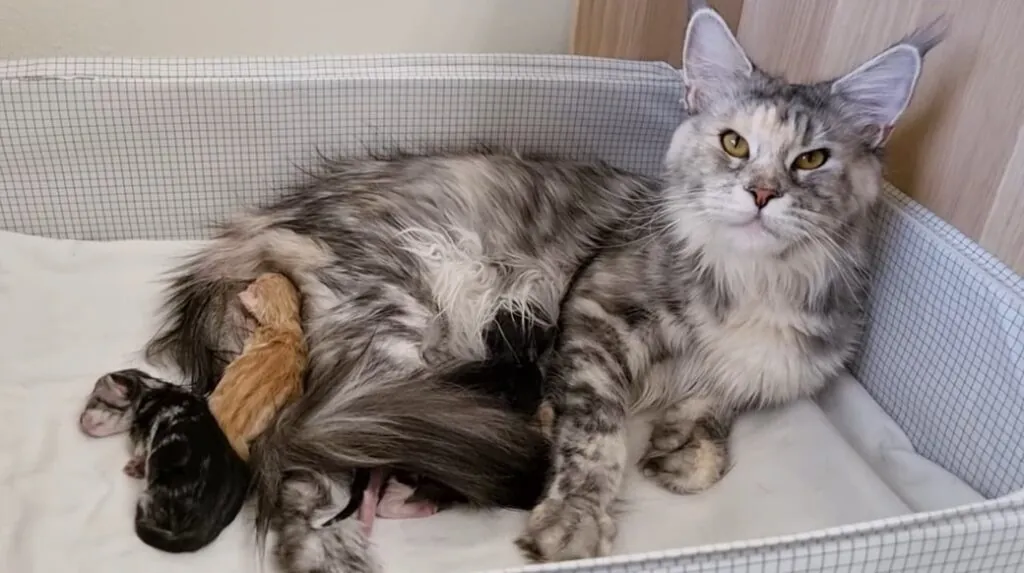
Even as Maine coon size captures our fascination, their reproduction and life cycles are brimming with equally intriguing tales yet to be told.
Mating System
Maine coons are typified as polygamous, that is, both males and females can mate with multiple partners over the span of a breeding season.
Reproductive Biology
Like most domestic cats, Maine coons are seasonal breeders. Their breeding season generally takes place in late winter or early spring – around February to April. They feature altricial parental care, implying the mother cat offers the primary care for the kittens until they’re weaned and independent. Maine coon’s litter size is 2 to 6 kittens, with an average of 4.
Gestation Period
The gestation period for the Maine coon is approximately 63 to 68 days, which is similar to other domestic cat breeds.
Life Cycle Stages
When it comes to the Maine coon lifespan, they can live up to 12 to 15 years, albeit some cats can live even longer with proper cate.
Mating Habits
| Mating Behavior Polyestrous | |
| Reproduction Season Primarily spring (April and May) | |
| Litter Size 1 to 5 kittens, with an average of 4 | |
| Incubation Period 63-70 days | |
| Baby Carrying Nestling occurs in the first few weeks, with kittens being fully weaned by 8-12 weeks | |
| Independent Age Around 6-8 months old |
Maine Coon Care Guide
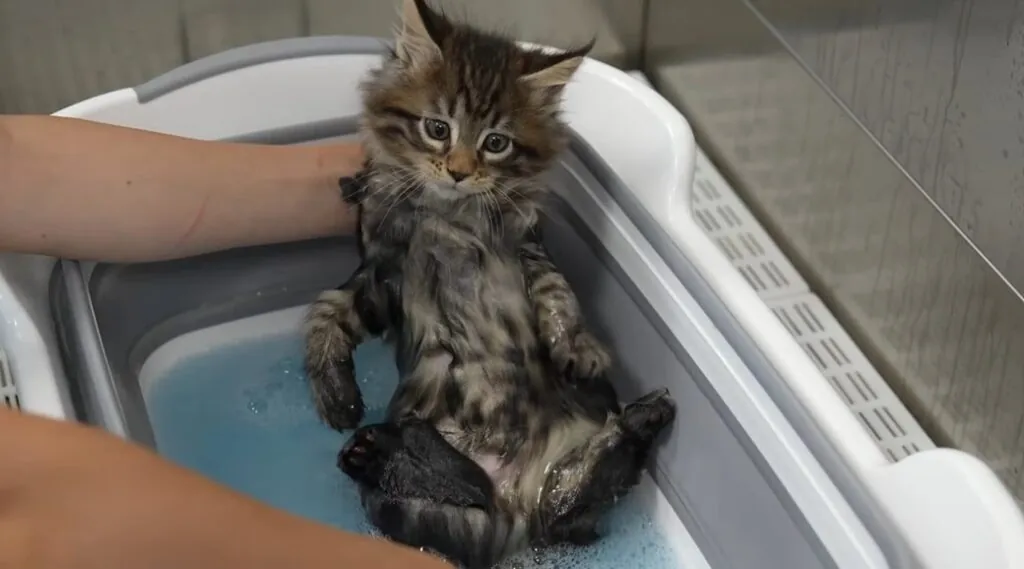
Adoption
Maine coon rescue organizations and shelters oftentimes have these magnificent felines waiting for their forever homes. Adoption not only grants a loving companion but also offers a second chance to deserving cat. If opting for a breeder, make sure they prefer ethical breeding practices, prioritize the health and well-being of their cats and screen for common Maine coon health issues.
Kittens
Before welcoming the Maine coon kittens, prepare your home by securing electrical cords, removing potential hazards and providing scratching posts and climbing structures to accommodate their playful nature. It’ll be a good idea to introduce your Maine coon kitten to different people, sights and sounds from a young age to ensure they become well-adjusted and comfortable in various situations.
Price
The Maine coon adoption fees from shelters or rescues generally encompasses vaccinations, spaying/neutering and microchipping. Fees can range anywhere from $50 to $300 depending on the location and resources of the shelter or rescue.
The Maine coon breeder coasts can vary significantly hanging on several factors, including bloodline, pedigree and breeder location.
It’s pivotal to avoid breeders with exceptionally low prices, as this may indicate unethical breeding practices that prefer profit over the health of the cats. A reasonable Maine coon kitten price range from a reputable breeder can be from $1,000 to $3,500.
Health Issues
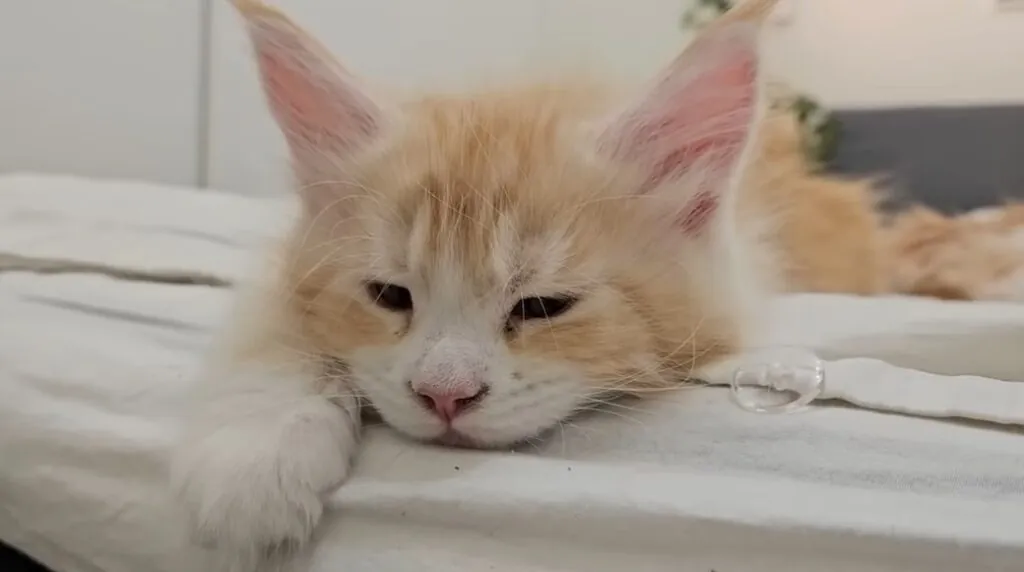
Though generally healthy, Maine coons are predisposed to certain condition like hip dysplasia, hypertrophic cardiomyopathy (HCM) and dental problems. You’re to schedule regular checkups with your veterinarian to monitor your Maine coon’s growth and development and identify any potential health concerns early on.
Allergies
While no cat breed is truly hypoallergenic, some breeds, such as the Siberian forest cat, are known to produce less Fel d 1 protein – a common allergen in cat dander. If you’ve cat allergies, speeding time with a Maine coon might spark allergy symptoms. Consult an allergist to discuss testing and potential management strategies before welcoming a feline friend. For more information on the history and care of this fascinating breed, visit the Cat Fanciers’ Association (CFA).
Food
Owing to the Maine coon size and longer growth period, they entail a high-quality diet rich in protein for muscle development, healthy fats for energy and coat health and essential nutrients. One point worth-mentioning when it comes to the Maine coon’s diet is over feeding can lead to obesity. You are to consult your veterinarian to pinpoint the appropriate portion sizes and feeding schedule.
Maine Coon Personality and Traits
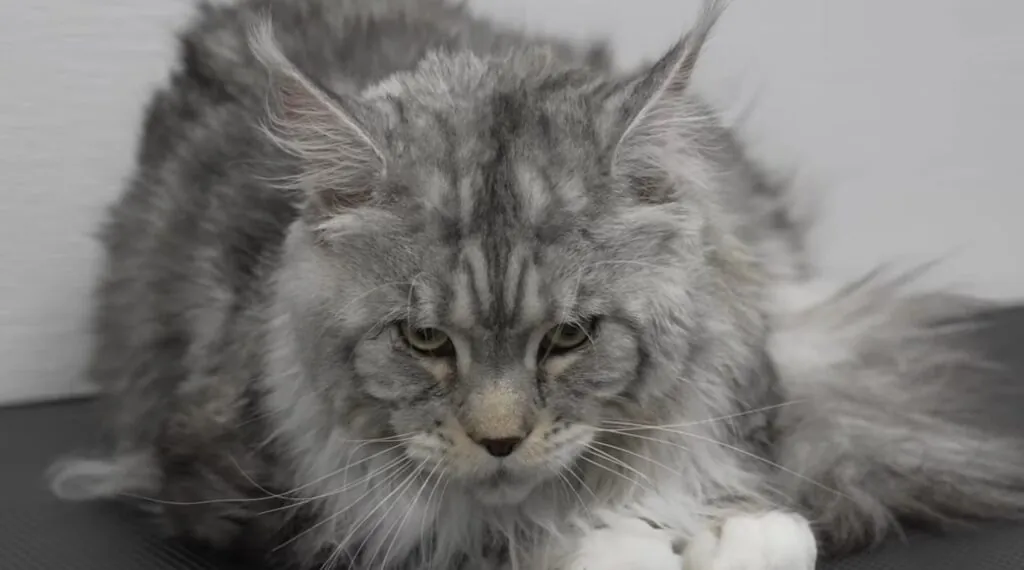
The Maine coon – renowned for its majestic size and luxurious coat – boasts an enthralling personality and set of traits. Let’s spotlight the specific characteristics that define these gentle giants.
Temperament
Contrary to their awe-inspiring size, Maine coons have loving and cuddly nature. Unlike their stereotypical feline aloofness, they often crave human interaction, seeking out gentle petting session and culling up on laps. Their gentle nature is balanced by a playful spirit. They retain a kitten-like enthusiasm well into adulthood.
Intelligence and Trainability
Studies propose that these gentle giants exhibit above-average cognitive abilities relative to other domestic cat breeds. This is evident in their swift comprehension of commands and their ability to learn complex tricks.
They sport a natural desire to please their companions, making them highly receptive to training. This inherent trait, in conjunction with the Maine coon’s intelligence, makes training sessions enjoyable and rewarding. They can learn various tricks – from simple commands like “sit” and “stay” to more complex behaviors like fetching or walking on a leash.
Personality
With respect to the Maine coon’s personality, they feature remarkable adaptability, in contrast with some cat breeds with specific environmental needs. From spacious houses to cozy apartments, they can thrive in a plenty of living situations, as long as their exercise and enrichment needs are adequately fulfilled.
If you properly direct the Maine coon’s behavior – particularly in terms of socialization, they can harmoniously coexist with children and other pets in the household. Their gentle and tolerant nature makes them suitable companions for families seeking a feline friend who enjoys gentle interaction and doesn’t exhibit excessive aggression.
Vocalization
The Maine coon’s vocalizations move over and above the typical meow. These include soft chirps, trills and gentle mews, each with specific meanings used to communicate their needs, desires and emotions. Explore the unique characteristics and history of the Maine Coon at the website of The International Cat Association (TICA).
Relationship with Humans
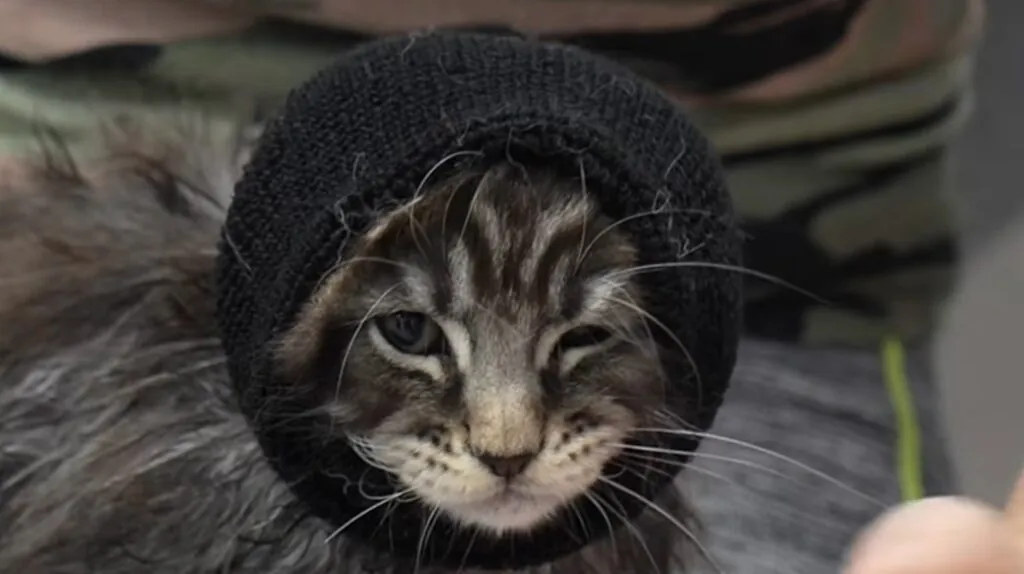
Cultural Significance and Symbolism
Some legends from Scandinavia, expressly Norway, whisper tales of the Skogkatt – a large, longhaired forest cat. Albeit not explicitly named as Mine Coons, these legendary felines were thought to sport magical powers and were oftentimes depicted as companions of the Norse goddess Freya.
Some Native American legends from the northeastern United States and Canada speak of large, powerful cats with distinctive marking akin to Maine coon.
The Takeaways
Forge a path through an intriguing journey as we unfold fascinating facts about Maine coons – truly captivating animals that start with M. Join us in shedding light on their remarkable rundown!
| Common Name | Maine Coon |
| Other Name(s) | Gentle Giant, Coonie |
| Number of Species | 1 (breed, not a separate species) |
| Lifespan | 10-15 years |
| Weight | 12-22 pounds (males), 8-15 pounds (females) |
| Length | Up to 40 inches (including tail) |
| Top Speed | 25 mph (estimated) |
| Predators | Domestic dogs, coyotes, foxes, birds of prey (for kittens) |
| Prey | Small rodents, birds, fish (primarily as toys) |
| Most Distinctive Feature | Long, flowing fur and a distinctive “raccoon-like” facial mask |
FAQs
